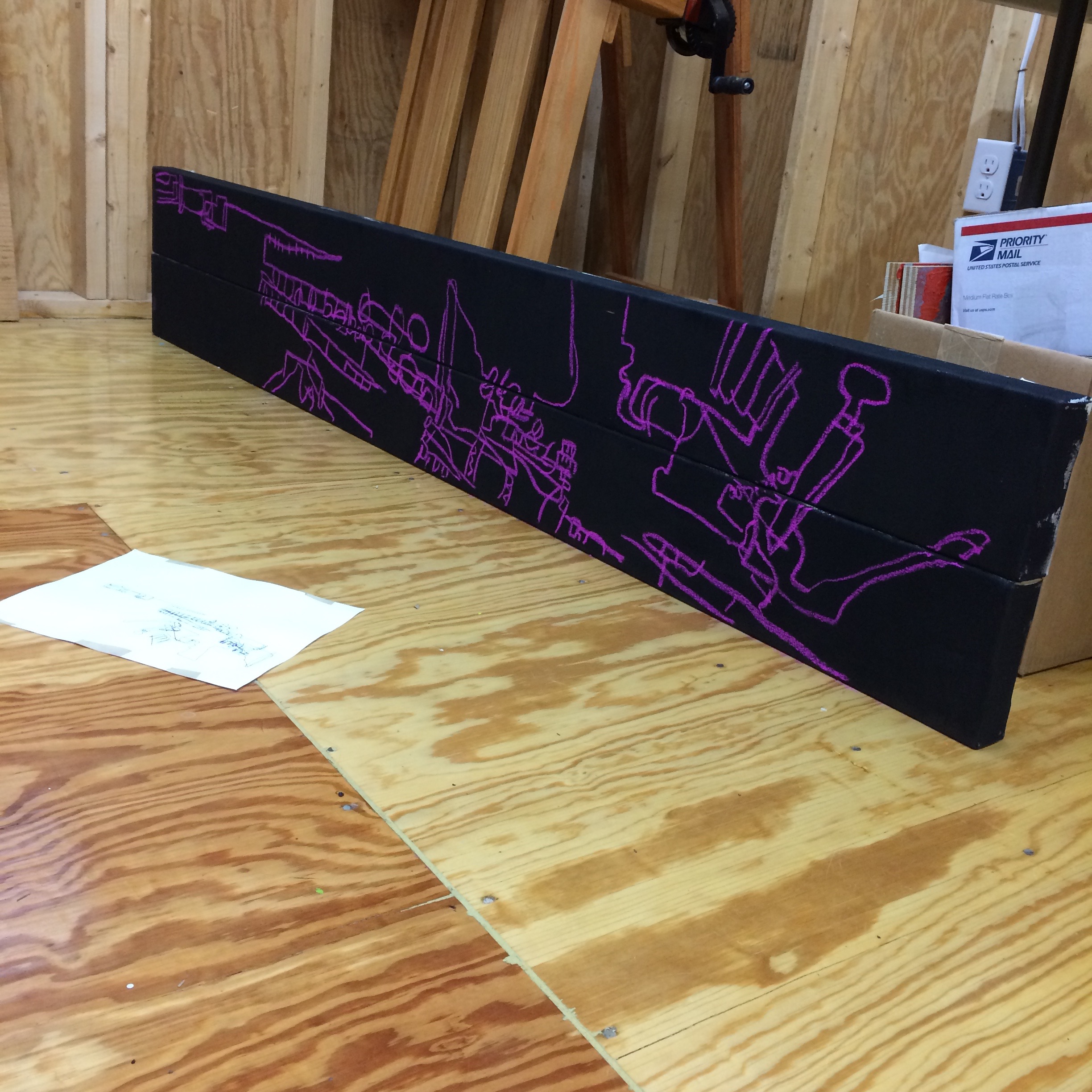Detail of "Urban Sniper" an example of one of the pieces in my current work that I used Blind contours in.
In middle school, I learned of this art exercise that changed my life and process as an artist. It is called blind contour. Traditionally, it was used to help with observation and to encourage the artist to trust their hand. Observation is key to drawing. I have been told over the years by my art teachers that you should observe twice as much as you draw. What makes a blind contour? To draw in this way, you don't look at your paper. Your eyes stay fixed on the object you are drawing. Another "rule" of creating a blind contour is that once your pencil (or pen in my case) touches your paper, you must not lift it. I start by picking a point of the object and then following the lines of the object. My blind contours are more than just the outline of the object. I include the lines that cut across it too and create the form. As I observe the object, I am trusting my hand to draw what my eye sees, which develops greater hand-eye coordination.
"Lilies" Watercolor and pencil on paper
I have been using blind contours in my finished work since I first learned about it. I enjoyed it so much that during my art lesson I decided to draw the lilies I was looking at with a blind contour. I drew one of the flowers and then I drew it again and again until my page was full of blind contour lilies. To make it a finished piece, I went back and watercolored the different shapes that the overlapping lines made (above). This piece marks the beginning of me using blind contours as the base or bones of my finished work, not just a warm-up exercise for my sketchbook. I have found that drawing from life brings life to my work. It adds interesting lines I would never have just drawn on my own. It brings a complexity as I blindly try to capture this wonderful world. It takes concentration and focus. On more complex objects , you have to remember where you started and where you have already drawn. There are times when I just completely forget whole sections of an object because I thought I’ve already drawn it..
Like this blind contour of a bike where I thought that I did both tires but I didn't do as much detail on the second one.
The way I add my blind contour to my canvas is with chalk pastels and a projector. One time did a piece where my blind contour was drawn directly on it (the canvas was smaller and fit in my lap). After doing the blind contour the lines became the first layer of this design, loosing all resemblance of what I was drawing.
With the projector, the drawing is also enlarged. As I think about tackling this large deployment piece, the drawings that I project onto the canvas are crucial to the overall message of the piece.




Sunday afternoon I packed up my sketch pad and a few favorite pens and headed off to a drawing date with my husband. My husband is not an artist by trade but he came to keep me company, add his input on what imagery would be critical in depicting his experience of deployments the last 15 years, and do some blind contours with me (because he loves me). We went to the Airborne Museum downtown and sat staring at a helicopter to do the first blind contours.
As we continued to draw different objects, we had some onlookers, kids and adults wondering, what are they doing? Right before we left, one of the museum staff got curious enough to ask. It was fun, challenging, and more emotional than I had anticipated. I was staring at things that are normal views for a soldier. I was faced with fear. I battle fear every time my husband deploys. As I drew, I faced it in a different way. A new way. I know there is danger, but this made it tangible. I didn't see the storm of fear coming, so when we tried to talk through the way this piece was depicted, my ears were plugged to what he was really saying....miscommunication happened and it took a good portion of the evening to untangle it.
Later we chatted together with a National Guard soldier who had just returned from his deployment (he crashed on our couch, awaiting in-processing before he could head home to WV) and I saw my next steps in gathering the content for this complicated piece. It is not just about two worlds, but the two perspectives of those worlds. The deployment world from the soldier’s perspective and the perspective of home from those who stay at home. We each have our battles for courage. We each have a choice to make. The choice we make each day, and many times throughout the day. How will we view this season of separation? Will we grumble and complain? Will we believe the other will never understand our obstacles or joys experienced? Or will we choose to persevere in untangling miscommunication even when they are not on the couch next to us. Will we see this time as a waiting and "lost" time, or a time to invest in our marriage in a different way?
My next task in preparing the imagery for this public work is to interview my husband to get a REAL feel about his perspective on deployment. I am thankful for our friend crashing on the couch and his valuable input on this complicated and long story I am trying to capture in 18, 96"x6" canvases.






